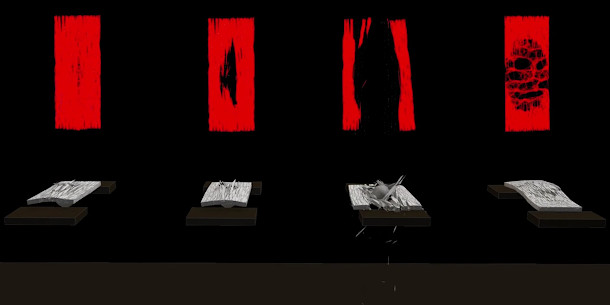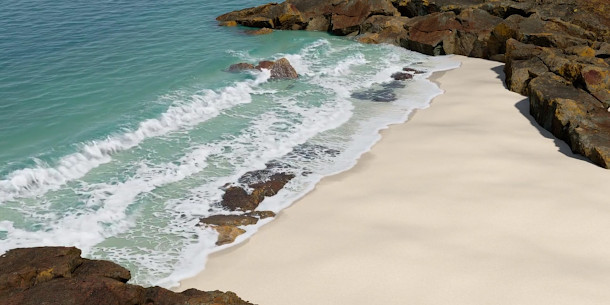SideFX ships Houdini 17
Originally posted on 27 September 2018. Scroll down for news of the commercial release.
SideFX has released a new sneak peek for Houdini 17, the next update to its 3D animation and FX software.
Unlike its Siggraph demo, which focused on the new PolyDraw direct modelling system, it shows what looks to be the entire feature set, including UVs; animation; hair, fluids and dynamics simulation; and rendering.
Highlights include Project Vellum, a new GPU-accelerated multiphysics solver, plus a new material-based fracturing framework, a new retiming operator for animations and simulations, and improved hair grooming.
The software is due to ship in mid-October.

Project Vellum: a new GPU-based multiphysics solver
To judge from the video, the biggest single new feature in Houdini 17 is Project Vellum, a “fast unified solver for cloth, hair, soft bodies and grains” inspired by Nvidia’s XPBD method.
Cloth simulation includes what looks to be at least a basic clothing toolset – the video shows clothing panels being created from curves – and the feature list at the end notes that cloth can be multilayered.
There are also some neat visualisation options, including heatmaps for bend and stretch angle and stress.

Soft bodies can be pressure-driven, strut-based or tetrahedral; and there are a few other interesting features, including plasticity – the image above shows grass staying flattened after being trodden down.
The solver is OpenCL-based, so it should work on any manufacturer’s GPUs, and integrates with Houdini’s existing crowd simulation tools.
Modelling: PolyDraw direct modelling toolset, new procedural modelling options
In the modelling toolset, the major addition still looks to be PolyDraw, which attempts to bring Houdini’s dirct modelling workflow more in line with that of other DCC software.
It’s only shown briefly in the new video, presumably because SideFX trailed it individually earlier in the year, so for a more detailed run-down of its features, check out our original story.
However, at 07:25, the new video lists a number of smaller workflow features, including the option to tint backfacing polygons in the viewport to help troubleshoot geometry.
Houdini’s procedural modelling toolset has also been extended, with six new or updated SOPs, including Falloff, Attribute Noise, Winding Number and Retime – about which, more later.

UVs: automatic seam detection and improved UV packing
The UV toolset also gets a significant update, including the new UV Autoseam operator: a heuristic seam detection system with the option to use a distortion tolerance slider to influence seam placement.
UV Flatten has been updated, with a handy-looking option to straighten out UV islands to help optimise UV packing, and the UV Layout operator has been “completely redesigned”, including new visualisation options.
Character animation: new full-body IK solver and pose space deformation toolset
For animators, major changes include a new full-body IK solver and a pose space deformation toolset.
Supported in other DCC tools like Maya, pose space deformation fixes artefacts in skin deformation by applying corrective blendshapes according to joint angles in the character rig.
The facial auto-rig is also described as new, although we aren’t clear from the video how it differs from the facial autorigging features announced in Houdini 16.5. More smaller features are listed at 07:28 in the video.
Rendering: built-in OptiX GPU denoising, light path expressions, and acceleration motion blur
In rendering, Houdini becomes the latest application to support a number of key industry technologies.
Those include Nvidia’s GPU-based, AI-driven OptiX render denoising system, also used in Arnold, V-Ray and Clarisse; Light Path Expressions; and layered Alembic files.
There are also a number of smaller workflow and performance improvements, listed at 07:30.

Rigid body dynamics: new material-based fracturing framework
Houdini’s simulation toolsets also see some major new features, including a new material-based fracturing framework capable of generating unique fracture patterns for concrete, wood and glass in destruction sims.
It supports heterogeneous constraints, including built-in Bullet physics soft constraints.
There are also new Voronoi 2.0 and Boolean Fracture tools.

Fluid simulation: revamped whitewater solver, retiming for Pyro FX sims
Over in the FLIP fluids toolset, the whitewater solver has been “completely redesigned”.
You can see the new solver in action in the image above: SideFX describes it as generating a more “organic look” to surface foam, with cellular patterns and repellent forces.
Performance of narrow-band fluid simulations, introduced in Houdini 16.5, has also been improved – you can see a side-by-side comparison at 06:00 – with SideFX claiming “4x faster initialisation”.
For gaseous fluids, the Pyro FX toolset gets built-in colour advection; and a “more granular” workflow for setting up simulations in SOPs.
Both Pyro FX and FLIP fluids simulations can also now be retimed – the new operator works with any animated geometry, apparently – which leads to impressively smooth-looking results at 05:30 in the video.

Other simulation types: better hair grooming and terrain generation
Hair simulation gets a number of new features, including the new Vellum solver, hair card generation for games, and “5x faster grooming performance”, largely due to faster calculation of guide hairs and clumping.
There are also new fractal clumping and recursive sub-clumping systems.
In terrain generation, there is a new heightfield distortion system, shown at 05:20; and the hydrological and thermal erosion systems have been “completely redesigned” with “higher quality” debris distribution.
Games tools: Houdini Engine for 3ds Max, new Unity plugin, glTF support
For games artists, there is a new third-party Houdini Engine plugin for 3ds Max, enabling Houdini assets to be imported into the software in an editable format, as with Maya, Cinema 4D, Unity and Unreal Engine.
The Unity plugin has also been “completely redesigned”, and now includes native terrain support.
Houdini also now supports the glTF data interchange format increasingly used in online and real-time tools.
Miscellaneous changes: improved Unified Noise, new Python API for custom viewport interaction
Other changes include updates to the Unified Noise VOP, which gets a new Periodic Noise system, plus initial 64-bit support and support for AVX.
There is also a new Python API for authoring custom viewport interactions: the demo shows it in use to create an in-viewport measurement tool.
Updated 10 October 2018: Houdini 17 is now shipping. SideFX has updated the ‘What’s New’ section of its website with a summary of the new features.
You can also see a recording of the company’s launch event – actually made last week in advance of the release – in the video above.
Pricing and availability
Houdini 17 is available for Windows 7+, Mac OS X 10.11+, and Linux distros.
The full Houdini FX edition costs $4,495 for a node-locked licence; $6,995 for a floating licence. Houdini Core, which lacks simulation tools, costs $1,995 for a node-locked licence; $2,995 for a floating licence.
There is also a free Houdini Apprentice learning edition and a lower-cost, rental-only Houdini Indie edition. Both save in their own file formats and have feature restrictions. See a product comparison table here.
Read an overview of the new features in Houdini 17 on SideFX’s website
Read a full list of new features in Houdini 17 in the online changelog
